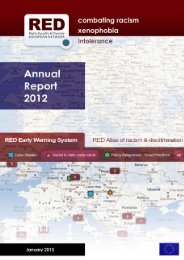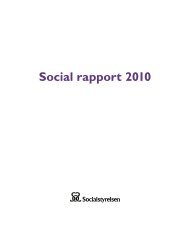R14PITFALLS AND BIASa child is ready for school when he or she reaches a certain age; this is <strong>the</strong> perspective on which compulsory schooling,<strong>and</strong> thus school readiness assessment at <strong>the</strong> age <strong>of</strong> compulsory schooling, is still based. In contrast, <strong>the</strong> Vygotskiansocio-historical developmental perspective is marked by a dynamic view <strong>of</strong> a child’s readiness for school, yetstill bound in a zone <strong>of</strong> proximal development. Fur<strong>the</strong>r, environmental factors can play into a child’s readiness forschool. Snow also points out that it is somewhat limiting to consider school readiness as an issue only for childrenages three to five; he determines that <strong>the</strong>re are very few studies <strong>of</strong> school readiness that address infancy <strong>and</strong>early childhood (2006, 27). All <strong>of</strong> <strong>the</strong>se issues contribute to Snow’s findings that school readiness assessment havelimited <strong>and</strong> mixed predictive validity for school success/outcomes (2006, 10).Increasingly <strong>the</strong> relationship between children <strong>and</strong> schools is moving away from a maturationist framework.Ra<strong>the</strong>r than place responsibility for being ready for school on <strong>the</strong> child, transitional, “interactional-relational”frameworks focus on <strong>the</strong> rights <strong>of</strong> <strong>the</strong> child <strong>and</strong> <strong>the</strong> reciprocal relationships among <strong>the</strong> child, families, <strong>the</strong> school,<strong>and</strong> <strong>the</strong> community (Bennet <strong>and</strong> Tayler 2006, 222; Snow 2006, 14; Kagan 2007, 22; High, 2008, 1009). Schoolreadiness is thus not easily defined; it is “multi-dimensional, highly variable, <strong>and</strong> culturally <strong>and</strong> contextually influencedover time” (Wesley <strong>and</strong> Buysse 2003, 353).High (2008, 1,010) identifies six misconceptions about school readiness as it is currently understood in schools:(1) Learning happens only at school.(2) Readiness is a specific condition within each child.(3) Readiness can be measured easily.(4) Readiness is mostly a function <strong>of</strong> time (maturation), <strong>and</strong> some children need a little more.(5) Children are ready to learn when <strong>the</strong>y can sit quietly at a desk <strong>and</strong> listen.(6) Children who are not ready do not belong in school.Children are usually assessed for readiness in kindergarten or before entering <strong>the</strong> first year <strong>of</strong> primary school.If a child is determined not to have attained <strong>the</strong> developmental maturity necessary for school, entrance maybedelayed for a year (or more in some countries), <strong>the</strong> child may be retained for a year in <strong>the</strong> same (st<strong>and</strong>ard)grade, or a child may be placed in an early intervention, transition, or preparatory class, or in a special educationclass. In almost all cases, <strong>the</strong> burden <strong>of</strong> pro<strong>of</strong> is on <strong>the</strong> child: The child must demonstrate her readiness to attendschool, but <strong>the</strong> school does not have to prove its readiness to accept <strong>the</strong> child <strong>and</strong> help him or her develop herskills. Herein lies <strong>the</strong> irony <strong>of</strong> school readiness testing: The very children who would benefit <strong>the</strong> most from early schoolexperiences are denied those experiences (see Shepard 1997, 85; Bennet <strong>and</strong> Tayler 2006, 13; Alcock, Holding, Mung’ala-Odera,<strong>and</strong> Newton 2008, 548; Gadeyne, Onghena, <strong>and</strong> Ghesqučre 2008, 454; <strong>and</strong> Panter <strong>and</strong> Bracken 2009, 398).
R15STREAMINGStreaming is <strong>the</strong> tracking, or division, <strong>of</strong> pupils based on <strong>the</strong>ir ability or achievement. Countries vary in how streamingis practiced <strong>and</strong> <strong>the</strong> ages at which children are streamed. In most Central European countries, pupils arestreamed before <strong>the</strong> age <strong>of</strong> 15 into schools selected (usually by parents <strong>and</strong> teachers) on <strong>the</strong> basis <strong>of</strong> academicperformance. Children in <strong>the</strong>se countries are accordingly placed in separate schools with particular dedicatedtracks — academic or vocational — grouped by ability. O<strong>the</strong>r countries have a comprehensive system <strong>of</strong> schooling,where all children in a particular geographic area attend <strong>the</strong> same school, but pupils might still be streamed,or tracked, into different academic tracks, <strong>and</strong> most <strong>of</strong> <strong>the</strong>ir classes will be homogeneously grouped by ability. Stillo<strong>the</strong>r countries, such as Finl<strong>and</strong>, do not stream children at all. All classrooms in all schools are grouped heterogeneously,with pupils <strong>of</strong> mixed ability levels. Streaming is distinguished from informal ability grouping in individualclassrooms, such as in-class reading or math groups, which are not permanent.Early research on ability grouping in both elementary <strong>and</strong> secondary schools (Slavin 1987, 1990) found that <strong>the</strong>rewas a very low positive achievement effect in homogeneous grouping. In fact, being in a low-ability tracked grouplimits student achievement (Boaler 2005, 137). However, learning toge<strong>the</strong>r with peers <strong>of</strong> differing ability levels<strong>of</strong>fers educational benefits to all pupils (Katz, Evangelou, <strong>and</strong> Hartman 1990; Bailey et al. 1998, 29). Internationalassessments <strong>of</strong> student performance in ma<strong>the</strong>matics <strong>and</strong> literacy 5 consistently find that streaming pupilsincreases inequities in educational <strong>and</strong> social opportunities <strong>and</strong> decreases <strong>the</strong> mean performance <strong>of</strong> a country’sstudent population (Hanushek <strong>and</strong> Woessmann 2005, 11; Luyten et al. 2005, 3). School tracking largely reinforcessocio-economic status, as in countries with tracked, selective school systems, socio-economic backgroundimpacts both <strong>the</strong> kinds <strong>of</strong> schools children attend <strong>and</strong> <strong>the</strong>ir performance on assessments (Schleicher, Tamassia,<strong>and</strong> Ikeda 2003, 28; Luyten et al. 2005, 62; Caro et al. 2009, 190). Conversely, in countries in which children arenot streamed <strong>and</strong> attend heterogeneously grouped comprehensive schools, student performance in literacy <strong>and</strong>ma<strong>the</strong>matics is higher, <strong>and</strong> <strong>the</strong>ir performance is impacted less by <strong>the</strong>ir socio-economic status (Luyten et al.2005, 89). Pupils from Finl<strong>and</strong>, who perform highest on all international measures, receive all <strong>of</strong> <strong>the</strong>ir schoolingin mixed-ability classrooms. The gap between higher- <strong>and</strong> lower-performing pupils is narrower in Finl<strong>and</strong> than ino<strong>the</strong>r countries, <strong>and</strong> <strong>the</strong> national percentage <strong>of</strong> lower-performing pupils is lower than in o<strong>the</strong>r countries (Haahr2005, 196).Children can also be streamed into segregated placements based on <strong>the</strong> determination <strong>of</strong> special educationalneeds. In most countries, assessment procedures for identifying special educational needs are built upon <strong>the</strong>medical model <strong>of</strong> disability, “aimed at intervention, remediation, care, <strong>and</strong> cure” <strong>of</strong> <strong>the</strong> deficit which is found in5 These international tests are Program for International Student Assessment (PISA), Progress in International Reading Literacy Study(PIRL), <strong>and</strong> Trends in International Ma<strong>the</strong>matics <strong>and</strong> Science Study (TIMSS, formerly Third International Ma<strong>the</strong>matics <strong>and</strong> Science Study).
- Page 3 and 4: R3CONTENTSACKNOWLEDGMENTS 4EXECUTIV
- Page 5 and 6: R5EXECUTIVE SUMMARYThis policy pape
- Page 7: R7For Romani children in Central an
- Page 10 and 11: R10PITFALLS AND BIAS4. Discontinue
- Page 12 and 13: R12PITFALLS AND BIASINTRODUCTIONThe
- Page 16 and 17: R16PITFALLS AND BIASthe child (Ryan
- Page 18 and 19: R18PITFALLS AND BIASTABLE 2. Placem
- Page 20 and 21: R20PITFALLS AND BIASAMONG THE ROOTS
- Page 22 and 23: R22PITFALLS AND BIASTAXONOMY OF “
- Page 24 and 25: R24PITFALLS AND BIASdevelop the ver
- Page 26 and 27: R26PITFALLS AND BIAS2008, 136). Ard
- Page 28 and 29: R28PITFALLS AND BIASBias in test ad
- Page 30 and 31: R30PITFALLS AND BIASWhile the test
- Page 32 and 33: R32PITFALLS AND BIASOF ROMANI CHILD
- Page 34 and 35: R34PITFALLS AND BIAStwo distinct ty
- Page 36 and 37: R36PITFALLS AND BIASPOLICY AND PRAC
- Page 38 and 39: R38PITFALLS AND BIASand had to repe
- Page 40 and 41: R40PITFALLS AND BIASOrientation Tes
- Page 42 and 43: R42PITFALLS AND BIASTABLE 5. Educat
- Page 44 and 45: R44PITFALLS AND BIASCOUNTRY-SPECIFI
- Page 46 and 47: R46PITFALLS AND BIASPLACEMENT IN SP
- Page 48 and 49: R48PITFALLS AND BIASCompulsory scho
- Page 50 and 51: R50PITFALLS AND BIASand Educational
- Page 52 and 53: R52PITFALLS AND BIAS121.1.cc.ii). A
- Page 54 and 55: R54PITFALLS AND BIASTest of School
- Page 56 and 57: R56PITFALLS AND BIASof the overall
- Page 58 and 59: R58PITFALLS AND BIASAS WITH OTHER C
- Page 60 and 61: R60PITFALLS AND BIASfirst grade, or
- Page 62 and 63: R62PITFALLS AND BIASbases listed in
- Page 64 and 65:
R64PITFALLS AND BIASof Societies in
- Page 66 and 67:
R66PITFALLS AND BIASTABLE 13. Pupil
- Page 68 and 69:
R68PITFALLS AND BIASROMANI CHILDREN
- Page 70 and 71:
R70PITFALLS AND BIASdetermined to c
- Page 72 and 73:
R72PITFALLS AND BIASdeveloped in th
- Page 74 and 75:
R74PITFALLS AND BIASWechsler Intell
- Page 76 and 77:
R76PITFALLS AND BIAStheir chances t
- Page 78 and 79:
R78PITFALLS AND BIASREPRESENTATION
- Page 80 and 81:
R80PITFALLS AND BIASTABLE 20.Enroll
- Page 82 and 83:
R82PITFALLS AND BIAS
- Page 84 and 85:
R84PITFALLS AND BIASGOOD PRACTICE A
- Page 86 and 87:
R86PITFALLS AND BIASStudent assessm
- Page 88 and 89:
R88PITFALLS AND BIASThe United King
- Page 90 and 91:
R90PITFALLS AND BIASor assistance i
- Page 92 and 93:
R92PITFALLS AND BIASTeachers report
- Page 94 and 95:
R94PITFALLS AND BIASTHE DETERMINATI
- Page 96 and 97:
R96PITFALLS AND BIASintellectual di
- Page 98 and 99:
R98PITFALLS AND BIAS8. Ensure that
- Page 100 and 101:
R100PITFALLS AND BIASANNEX 1:RELIAB
- Page 102 and 103:
R102PITFALLS AND BIAS1. Does the te
- Page 104 and 105:
R104PITFALLS AND BIASANNEX 2:COMPON
- Page 106 and 107:
R106PITFALLS AND BIASFIGURE A4. Sam
- Page 108 and 109:
R108PITFALLS AND BIASAshton-Warner,
- Page 110 and 111:
R110PITFALLS AND BIASCahn, Claude,
- Page 112 and 113:
R112PITFALLS AND BIASD.H. and Other
- Page 114 and 115:
R114PITFALLS AND BIASFigueroa, Rich
- Page 116 and 117:
R116PITFALLS AND BIASGovernment of
- Page 118 and 119:
R118PITFALLS AND BIASHayman, Robert
- Page 120 and 121:
R120PITFALLS AND BIASKovács-Cerovi
- Page 122 and 123:
R122PITFALLS AND BIASMacura-Milovan
- Page 124 and 125:
R124PITFALLS AND BIASMoore, Tom. 20
- Page 126 and 127:
R126PITFALLS AND BIASRadivojevic, D
- Page 128 and 129:
R128PITFALLS AND BIASShepard, Lorri
- Page 130 and 131:
R130PITFALLS AND BIASTomatová, Jan
- Page 132 and 133:
R132PITFALLS AND BIASVláda Česká
- Page 134:
Copyright © 2012 Roma Education Fu




